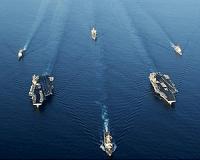| . |  |
. |
Wellington, New Zealand (UPI) Feb 18, 2011 The second phase of a $58 million systems upgrade aboard New Zealand frigates Te Kaha and Te Mana is under way, Defense Minister Wayne Mapp said. Design and manufacturing contracts were awarded to Siemens, Noske-Kaeser, Australian Marine Technologies and ThyssenKrupp Marine Systems Australia. "The ANZAC Platform Systems Upgrade contracts will allow the navy to leverage-off the technology developments that have been made over the past 20 years," Mapp said. Work includes improvements to the ships' overall management systems as well as heating, ventilation air conditioning units to boost automatic control and monitoring. Importantly, it will allow the ships to operate better -- and give better working and living conditions to sailors -- in a wider range of climate extremes. "Our navy works closely with other countries and is a valued international partner in our region's security arrangements," Mapp said. "This upgrade in our frigates' capability will improve the performance and extend the range of conditions in which they are effective." The upgrade work will be carried out in New Zealand as well as Australia, Canada and Germany. The Te Kaha and Te Mana are two of the 10 ANZAC class frigates built in Australia by Tenix Defense Systems in Williamstown, and the only ANZAC vessels serving with the New Zealand navy. Te Kaha was laid down in 1994 and commissioned into the RNZN in 1997, followed by the Te Mana, launched in 1997 and commissioned in December 1999. The 387-foot-long ships with ranges of more than 7,000 nautical miles are "the mainstay of the navy's combat force," the Defense Ministry said. They have a 5-inch gun, torpedoes, air defense missiles and close-in weapons systems for self-defense. The frigates also carry a Kaman Aerospace SH2G Seasprite helicopter armed with air-to-surface missiles. Since late 2009 both ships have undergone upgrades, including major engine work during the first phase. The propulsion upgrade included Babcock Fitzroy replacing the ships' diesel engines, and related power and cooling systems, with more powerful units that deliver better fuel efficiency. The ships were in dry dock for the engine project that required hull plating to be removed to exchange the engines. Extra power is needed because the ships' upgraded systems add weight -- as do the expanded facilities for the increase in crew numbers -- to the vessels, a Defense Ministry document explained. "The most noticeable change is the partial enclosing of the quarterdeck," the document said. "This has reduced the overall area on the quarterdeck but has created additional internal space. Creating the internal space has increased the reserve buoyancy in the after sections of the ship improving the ANZACs' (ships') ability to withstand damage in this area." Crew also benefit from some added comforts. A gymnasium is planned as well as an expanded laundry area.
Share This Article With Planet Earth
Related Links Naval Warfare in the 21st Century
 Onr Develops New Acquisition Model For Delivering Information To The Fleet
Onr Develops New Acquisition Model For Delivering Information To The FleetArlington, VA (SPX) Feb 14, 2011 To rapidly develop a new way to deliver information to the fleet, the Office of Naval Research (ONR) has created a unique acquisition approach that developers will outline at the Feb. 22-24 Institute of Electrical and Electronics Engineers (IEEE) conference in Miami. The Command and Control Rapid Prototyping Continuum (C2RPC), a collaborative effort between ONR, the Program Executive Offic ... read more |
|
| The content herein, unless otherwise known to be public domain, are Copyright 1995-2010 - SpaceDaily. AFP and UPI Wire Stories are copyright Agence France-Presse and United Press International. ESA Portal Reports are copyright European Space Agency. All NASA sourced material is public domain. Additional copyrights may apply in whole or part to other bona fide parties. Advertising does not imply endorsement,agreement or approval of any opinions, statements or information provided by SpaceDaily on any Web page published or hosted by SpaceDaily. Privacy Statement |